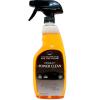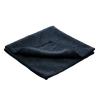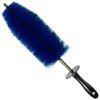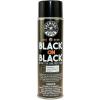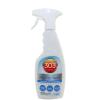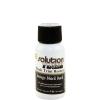Auto Detailing Guide - Engine Bay

Is It Safe To Detail Your Engine Bay? (Return to Top)
Detailing the engine bay can often seem overwhelming and potentially scary but in reality it's one of the easiest areas to care for. Many owners fear they will ruin some part of the engine with a simple cleaning, but the truth is the modern day engine bay is so well protected it's hardly a concern anymore. With minimal effort you will be amazed at how easy and affordable it is to make your engine bay look like new again. You only need a degreaser, protectant, protectant applicator and a cloth or brush to work in the degreaser. The process should only take 20 - 45 minutes depending on how dirty the engine bay is.
How Often Should You Detail Your Engine Bay? (Return to Top)
The engine bay should be detailed every 3 - 6 months to keep it clean and well protected.
Prep Work and Precautions (Return to Top)
While the vast majority of vehicles are extremely easy and safe to work on we'll go over some basic precautions that apply to some select vehicles. If you are working on a classic car or any older model (mid 1990's and older) you may want to be extra cautious. Electrical components are generally well covered, but if you have any visible avoid hitting them with a high pressure water flow. They are meant to resist moisture but it's possible to get water in there if you were careless or if they were defective. To be conservative wrap exposed electrical connections in tin foil. The air intakes are usually protected but avoid hitting them with a direct stream of water, if needed cover them with a plastic bag because you don't want to flood the air intake with water. If you have an exposed aftermarket air filter make sure it's covered by a plastic bag. If you have any exposed belts or fans cover them up with a plastic bag or tin foil. After you have checked off these areas you are ready to begin detailing. Again most of these areas are not of concern to the modern day vehicle but you should check just to be safe.
How To Detail Your Engine Bay (Return to Top)
- Step 1: Prior to starting, the engine bay should not be hot but it's okay if it's just barely warm. Some detailers will turn the car on for 1 - 2 minutes just to get it a little bit warm.
- Step 2: Mist a light degreasing solution across the entire engine bay including the flipped up hood. Let it dwell for at least 1 - 2 minutes.
- Step 3: Agitate visible build ups with a brush or rag. A small brush like the Mini EZ Detail Brush is very helpful as it get's in to those tough to reach areas with ease.
- Step 4: Apply a fine mist of water starting top down to rinse away the dirt and contaminants.
- Step 5: Spot treat any remaining areas and re-rinse the engine bay down with a fine mist of water.
- Step 6: Dry the engine bay top down with a microfiber towel and you should see a noticeable improvement already. If needed, use compressed air beforehand to help remove any small pools of water that may be hard to access.
- Step 7: If any of the vinyl, plastic, or rubber are faded use a product like the Chemical Guys Black on Black or the TUF SHINE Black Restore to bring a darker and richer appearance back. If the material is not faded but you'd like to provide a darker appearance and protection, apply your favorite protectant to the surface. The 303 Aerospace Protectant is a popular choice as it leaves outstanding protection and adds a like-new finish to anything vinyl, plastic and rubber. Do not apply the protectant or cleaners to any mechanical pieces like moving belts and fans.
- Step 8: Remove any plastic bags or tin foil you used and start the engine just to be certain you are all set.
Upon completion the engine bay should look outstanding and be protected for months to come!
Product Recommendations
Facts and Tips (Return to Top)
- Many fear cleaning the engine bay when it's actually one of the easiest areas to care for
- It can take as little as 20 minutes to clean and protect the entire engine bay
- The modern day engine bay is so well protected it's quite easy and safe to care for
- A degreaser, protectant and cloths are all you need
- Generally speaking water will not harm the engine bay, it's designed to resist moisture
- Don't use WD-40 or Windex to clean the engine bay
- Clean and protect the engine bay at least twice per year
- Don't forget to care for the hood that gets flipped up
- An EZ Detail Brush can help you reach down in to the engine bay
Related Articles (Return to Top)
Here are a few articles related to Engine Bay Detailing from our Ask-a-Pro Detailer Blog:
- 2006 Acura TL in Nighthawk Black Pearl Part 1
- How to Detail Your Engine Bay
- Product Review and Guide: 303 Aerospace Protectant
- Why You Need a Bottle of the Multi Purposefull Klasse AIO
- Product Review: DI Boars Hair Detailing Brush
- Product Review: Chemical Guys Fade 2 Black
- 2008 m6 in Black Sapphire Metallic
- Product Review: Mini EZ Detail Brush
- Ferrari f40 60 Hour Restorative Detail by Todd Cooperider and Craig Reed
- Learn Something New, Don't Read the Instructions

